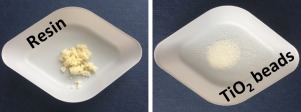Catalysis Today ( IF 5.2 ) Pub Date : 2018-06-25 , DOI: 10.1016/j.cattod.2018.06.031 Q.A. Naqvi , M. Ratova , R. Klaysri , P.J. Kelly , M. Edge , S. Potgieter-Vermaak , L. Tosheva

|
TiO2 in the form of macroscopic beads was prepared by resin templating. Anion-exchange macroporous resin beads were treated with a synthesis gel containing titanium isopropoxide, iso-propanol and diluted (0–5 wt.%) tetrapropylammonium hydroxide (TPAOH) aqueous solutions. The Ti-resin composite obtained was calcined at 600 °C to remove the resin. The presence of TPAOH in the precursor solution was essential for producing intact TiO2 beads. The use of 1–1.5 wt.% TPAOH resulted in anatase beads, whereas further increase in the TPAOH content promoted the anatase to rutile phase transformations. Decreasing the heating rate used during calcination also resulted in changes in the TiO2 composition from pure anatase (16 °C min−1 heating rate) to anatase with rutile impurities (0.5 °C min−1 heating rate). The photocatalytic activity of the TiO2 beads was evaluated for the degradation of acetone under ultraviolet irradiation. A high activity was displayed by the TiO2 samples composed of anatase with rutile impurities, whereas the activity was lower for pure anatase samples or samples containing mainly rutile. The TiO2 beads showed higher rates of charge carrier generation and slower charge trapping/recombination rates compared to a reference Cristal ACTiV™ PC500. In addition, the TiO2 beads could be used in at least five consecutive catalytic cycles without any in-between cycle treatment, without significant changes in their activity. The TiO2 beads prepared in this work are beneficial for photocatalytic applications in the gas-phase compared to powders due to easy handling, reduced pressure drop and attrition resistance.
中文翻译:

调整多孔树脂模板化的TiO 2大珠的组成,以优化光催化性能
通过树脂模板制备宏观珠粒形式的TiO 2。用含有异丙醇钛,异丙醇和稀(0-5重量%)的氢氧化四丙基铵(TPAOH)的合成凝胶处理阴离子交换大孔树脂珠。将得到的Ti树脂复合材料在600℃下煅烧以除去树脂。前体溶液中TPAOH的存在对于生产完整的TiO 2珠至关重要。使用1–1.5 wt。%的TPAOH会产生锐钛矿珠,而TPAOH含量的进一步增加则促进了锐钛矿向金红石相的转化。降低煅烧过程中使用的加热速率还会导致TiO 2组成从纯锐钛矿变化(16°C min -1加热速率)到金红石型杂质的锐钛矿(加热速率0.5°C -1 -1)。评价了TiO 2珠的光催化活性,以评价其在紫外线照射下丙酮的降解。由具有金红石杂质的锐钛矿组成的TiO 2样品显示出高活性,而对于纯锐钛矿样品或主要含有金红石的样品,其活性较低。与参考Cristal ACTiV™PC500相比,TiO 2珠粒显示出更高的电荷载流子生成速率和更慢的电荷俘获/复合速率。另外,TiO 2珠子可至少在五个连续的催化循环中使用,而无需任何中间循环处理,其活性也无明显变化。与粉末相比,由于易于处理,降低的压降和耐磨损性,与粉末相比,在这项工作中制备的TiO 2珠有利于气相中的光催化应用。









































 京公网安备 11010802027423号
京公网安备 11010802027423号